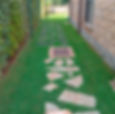Zoysia matrella (Arabic Grass): Benefits, Lawn Care & Growing Guide
- BeyondForest
- May 12
- 5 min read
Updated: Nov 6
Image of Arabica Grass by Elisha Omuse
2.)Advantages of Arabic grass
3.)Disadvantages of Arabic grass
4.)Maintenance and Care of Arabic Grass
5.)Uses of Zoysia matrella (Arabic Grass)
Arabic grass performs best with a height maintained at 1–2 inches
An acre is 4046.85msq a 50kg bag covers 25sqm depending with spacing so u only need 162bags -Phillip Mutua
Zoysia matrella, commonly known as Manila grass, Arabica or Arabic grass, is a popular warm-season turfgrass appreciated for its fine texture, dense growth, drought resistance, and ability to form a lush, green carpet.
According to some landscapers 1 acre of land can fit 100 to 150 50 Kilogram bag of Arabica grass
Arabic grass also known as Carpet Grass

Image of Jane Wambui a Pro Landscaper on Arabic grass
Native to Southeast Asia and the Pacific Islands, Zoysia matrella has found a firm place in landscaping, golf courses, public parks, and high-end residential lawns across tropical and subtropical regions, the leaf texture is fine-bladed and soft, ideal for barefoot walking .The growth habit is Low and forms a dense mat through stolons and rhizomes
Arabica grass Spreads slowly via surface runners (stolons) and underground stems (rhizomes)

Image of Arabic Grass by Jane Wambui on Facebook
Arabic grass is a heavy feeder, hates traffic and uneven watering.-John

Image of 3 Year Old Arabic grass by Erick Mutuma
I put lots of Manure while I planted and I have never placed another manure again- Erick Mutuma

Image of Arabic Lawn Grass by Caren Muthoni
Excellent Drought Resistance
Once established, Arabic grass survives with minimal irrigation, making it ideal for water-scarce areas.
Top dress your Arabic grass with red soil. Arabic after 3 years of it's life it begins to die of so it needs top dressing every year with red soil. You literally cover it up with red soil it will be green again but the surest way is uprooting and replanting which is a big job and it was for this exact reason that I uprooted and planted Pemba grass I have never been happier. -Nick
Hi, I’m Evans. Need Data Research or Analysis?
I help businesses gather the right data and turn it into actionable insights.
Dense and Weed-Resistant
Its tight growth habit chokes out weeds naturally, reducing the need for herbicides.
Low Mowing Frequency
It grows slowly compared to other grasses like Kikuyu or Bermuda, needing mowing once every 2–3 weeks.

Shade Tolerance
Can tolerate up to 40–50% shade, outperforming many other warm-season grasses.
Pest and Disease Resistance
Arabic Grass is rarely affected by fungal or insect infestations when well-maintained.
Disadvantages of Arabica Grass

While Arabic grass is low-maintenance, it needs proper fertilization for optimal growth and color. However Arabic grass require alot of water as some challenges faced by lawn owner who have arabic grass end up being frustrated the lawn turning yellow and drying
Grows slowly from seed (if available); usually established via sod, plugs, or stolon which can be expensive.

Image of worms invading Arabica grass a post by Mike Kyalo
Not suitable for highland or frost-prone regions — turns brown in cold temperatures.
Zoysia matrella /Arabic grass is mostly propagated by Sod (turf rolls) ,Splits while Seed propagation is rare, due to low germination rates

Image of Arabica Grass By Elisha Omuse
Though relatively low-maintenance, Arabic grass performs best with the following practices:
🌱 Mowing
Maintain at least 1–2 inches height. Mow with a sharp reel mower for best appearance. Avoid scalping — never remove more than 1/3 of the blade height.
💧 Watering
Once established, water deeply once or twice a week.
Avoid daily shallow watering which encourages shallow root growth.
🌿 Fertilizing
Apply balanced fertilizer (e.g., NPK 10:10:10) every 6–8 weeks during the growing season.
Avoid over-fertilizing, which can lead to thatch buildup and diseases.
🧹 Weed and Thatch Control
Use pre-emergent herbicides during dormant months.
Dethatch once a year if needed using a rake or dethatcher machine.
🌾 Aeration
Aerate soil annually to improve root penetration and water infiltration.
Zoysia matrella is ideal for warm, sunny climates with moderate rainfall.Requires 6–8 hours of full sunlight daily; tolerates partial shade better than Bermuda grass

In terms of Salinity it is High tolerance and very suitable for coastal areas
Uses of Zoysia matrella (Arabic Grass)
Home Lawns – Soft texture and aesthetic appeal make it a top choice for upscale lawns.
Golf Courses – Used on fairways and tees due to its resilience and uniform appearance.
Public Parks & Schools – Handles heavy foot traffic while remaining attractive.
Hotels & Resorts – Perfect for ornamental lawns and poolside areas.

Image of Arabic grass on 50 Kilogram sacks
Football Fields – Provides a firm, cushioned surface with quick recovery.
Erosion Control – Its rhizome system binds soil on slopes and banks.

Image of Arabica Grass By Elisha Omuse
FAQ About Arabic Grass
According to Floral Garden Arabic grass green soft carpet like appearance is achievable through sufficient timely watering, proper weed control and a fortnight mowing calendar.
Watch for pests like armyworms or fungal infections, especially during wet conditions.

Image of Arabic grass on 50 Kilogram bag by Golden Landscape
To also ensure that the Arabic grass is well maintained avoid planting in deep shade as it may thin out as Arabic grass thrives in full sun . Best time to water Arabic grass is early morning to prevent fungal issues Water daily for the first 2–3 weeks until established. Water deeply but infrequently — about 2–3 times per week.
Overwatering Arabic grass causes fungal problems and encourages shallow roots also ensure trees or shrubs don’t completely shade the lawn

Mow every 2–3 weeks during the growing season Keep grass at about 1–1.5 inches (2.5–4 cm). Use sharp blades to avoid tearing the fine grass blades.
If you want the best outcome for grass let chemicals be your last option. First if you don't need the current grass dig it completely. Make sure you remove all weeds. Then plant your grass of choice and enough manure. Recommended goat manure. Make sure you have plenty of water during planting season and while maintaining be removing any weed that tries to grow. Eventually you will have a beautiful lawn- Kajoni

Image of a Post on X by Social Experiment commenting on Arabic grass
Arabic grass, an ornamental lawn variety with fine, lush green blades, cost 1,000Ksh for a 50-kilogram bag, both Nursery Owners and on Jiji. Ideal for landscaping and beautification, it creates a soft, carpet-like cover. Its uniform growth and rich color make it perfect for gardens, walkways, and recreational spaces.
"Buy 60 bags of Arabic and do not accept them to sell to you with the cement bag but rather the sugar bag , while planting try and remove the splits"-Leaky Landscaper
According to Social Experiment Arabic grass needs a lot of water not sure about the quantity, but the area with Arabic grass is flooded for about 2 hours, 4 days a week and then added chicken manure for Nitrogen

Image of Carnations Landscape Putting lime on top of the arabica grass that helps in soil ion boosting
Kikuyu grass is better for grazing and erosion control due to its fast growth and high biomass. Arabica paspalum is more suited for humid, lowland areas and provides softer forage. Kikuyu is hardier and more aggressive, while paspalum offers better ground cover and palatability in wetter climates.
Kikuyu grass is coarse-textured, fast-growing, and thrives in highland and cool tropical areas. It is drought-tolerant and aggressive, making it ideal for grazing and erosion control. Bermuda grass, on the other hand, has finer leaves, grows well in warm climates, and spreads rapidly via runners. It recovers quickly from grazing or mowing and is commonly used in sports fields and lawns.






